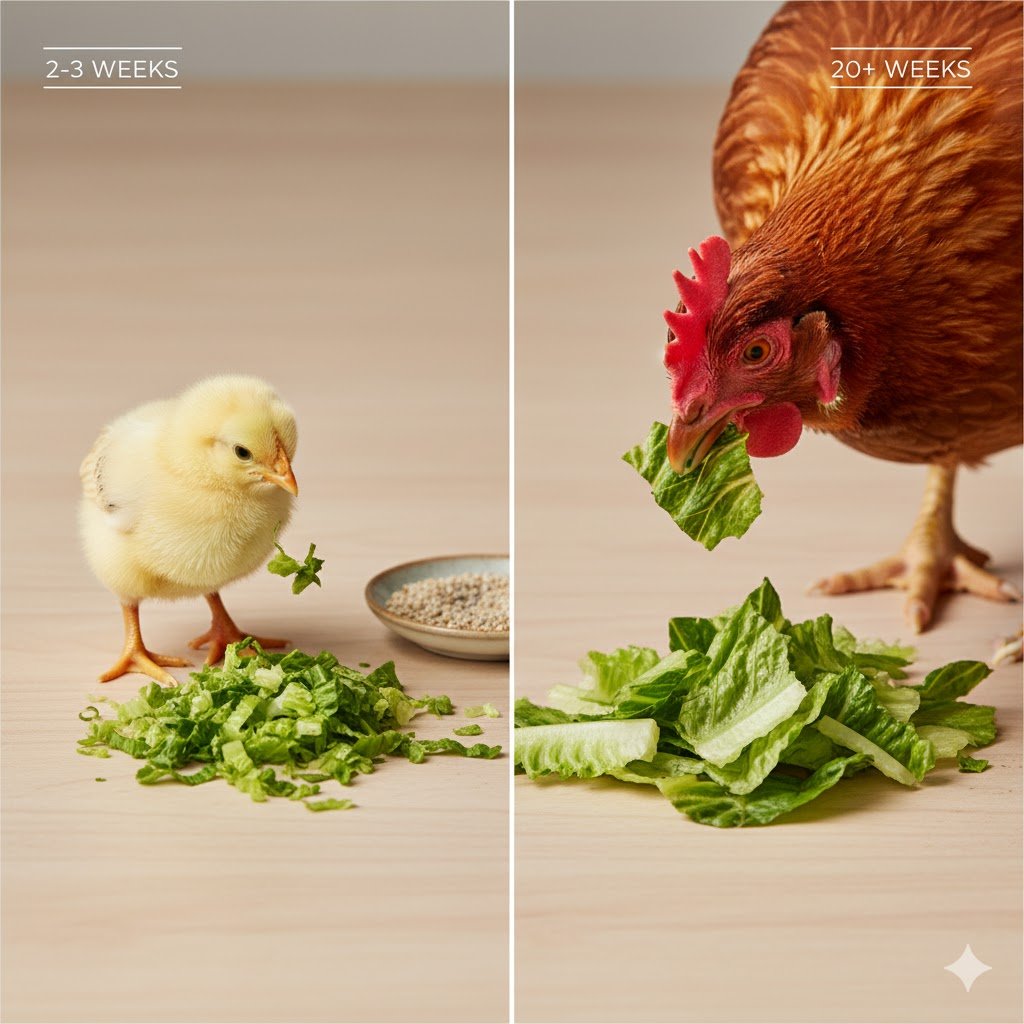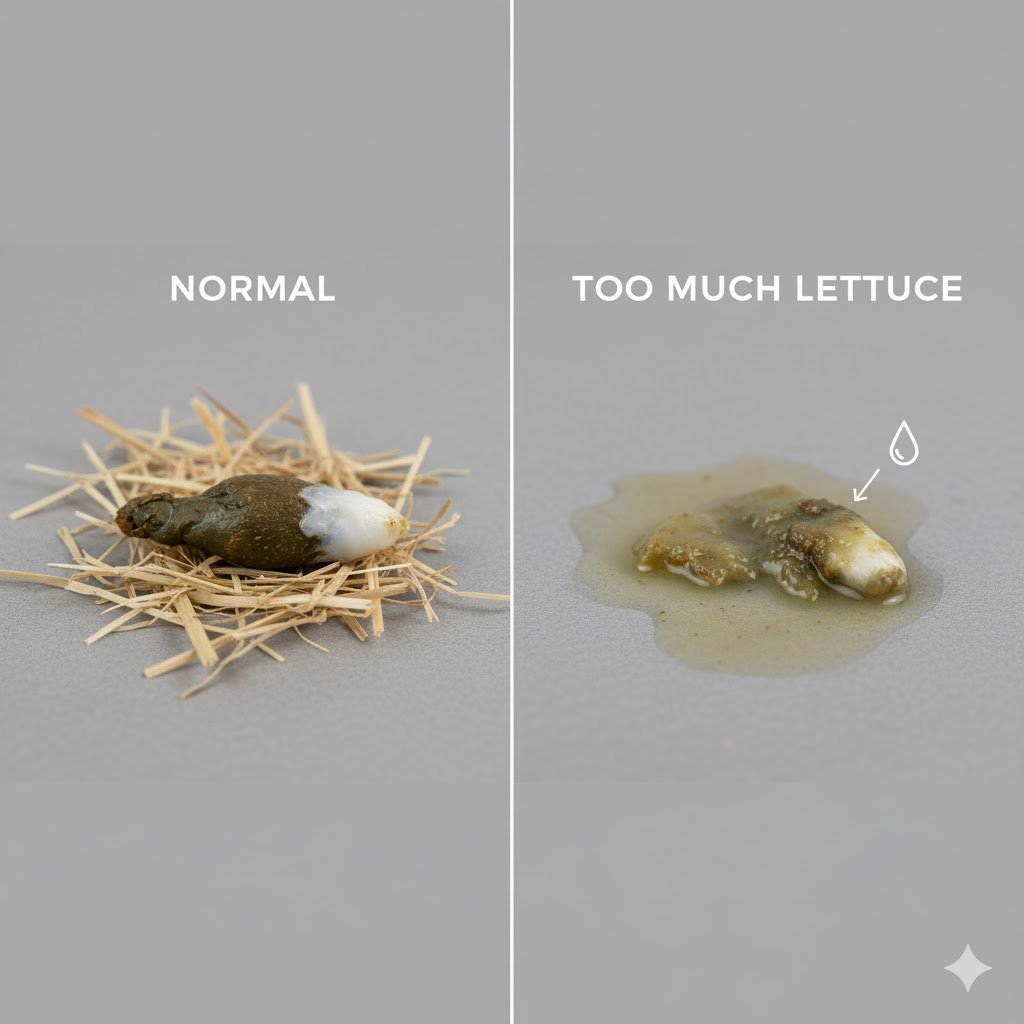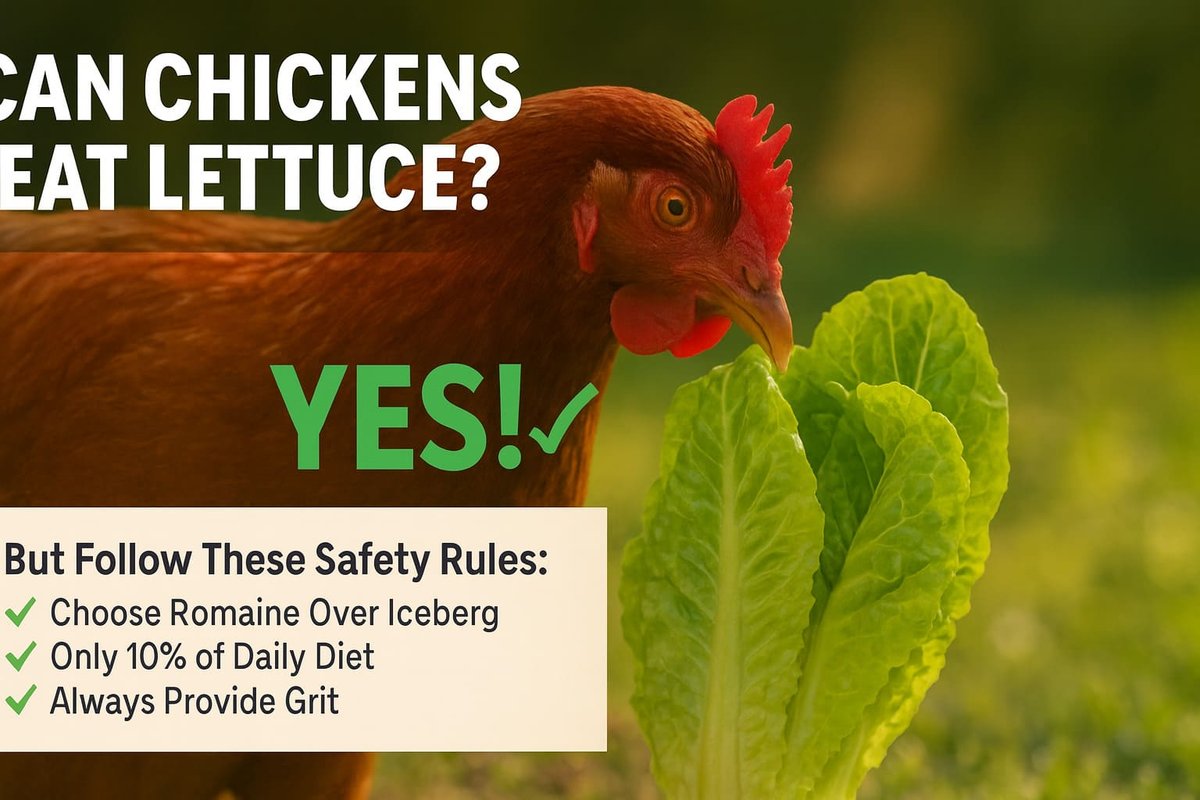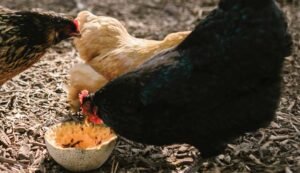Yes, chickens can absolutely eat lettuce, and most backyard flocks love it as a healthy treat. However, not all lettuce types are equally nutritious, and feeding guidelines matter for your hens’ health and egg production. As a backyard chicken keeper for over seven years with a happy flock of Rhode Island Reds and Orpingtons, I’ve tested various lettuce types and learned a lot about what works best. My chickens will sprint across the yard for leafy greens, but I’ve also learned that moderation is key.
In this guide, you’ll discover which lettuce varieties provide the most nutrition, how much to safely feed your chickens, what age chicks can start eating lettuce, and common mistakes that could harm your flock. Following a complete feeding guide for chickens ensures your chickens get all the benefits of lettuce without compromising their main diet.
The Quick Answer: Can Chickens Eat Lettuce?
Yes, chickens can safely eat lettuce as part of a balanced diet. It’s a healthy, hydrating treat that most flocks love.
- Safe Lettuce Types: Romaine, Leaf Lettuce (red and green), and Butter Lettuce are excellent choices.
- Use in Moderation: Lettuce should be a treat. It should only make up about 10% of your chicken’s daily diet.
- Portion Size: This equals about 1-2 tablespoons of chopped lettuce per full-grown bird per day.
- Avoid: Never feed your chickens lettuce that is moldy, spoiled, or has been treated with pesticides.
Understanding the Lettuce Controversy: Why Some Say Chickens Can’t Eat Lettuce
You may have heard rumors that lettuce is dangerous for chickens or can cause health problems. This concern mostly comes from two things: low nutrition and diarrhea.
The myth is that lettuce can cause issues like crop impaction. The truth is, this is extremely rare. The real issue is that some types, like iceberg lettuce, are very low in nutrients and are mostly water. If a chicken fills up on iceberg lettuce, it’s getting “junk food” with no real value. This can also lead to watery droppings (diarrhea), which isn’t harmful as a one-time thing but isn’t ideal.
From my experience raising chickens, I’ve fed lettuce safely for years without any crop issues. The key is to choose nutritious lettuce and not overdo it. In fact, according to poultry extension guidelines from various agricultural universities, lettuce is a safe treat when fed in moderation. Reputable sources like Purina Animal Nutrition confirm this approach, emphasizing that treats should not replace a balanced feed.
What Kind of Lettuce Is Good for Chickens? A Complete Comparison

Not all lettuce is created equal. Darker, leafier greens are packed with more vitamins and minerals than light-colored, watery ones.
Here’s a simple breakdown:
| Lettuce Type | Nutritional Value | Benefits | Considerations |
|---|---|---|---|
| Romaine | High | Rich in vitamins A, C, & K. Helps create orange yolks. | The best all-around choice for regular feeding. |
| Leaf Lettuce | High | High water content for hydration. Red leaf has more antioxidants. | Great for hot summer days. Chickens love it. |
| Butter Lettuce | Medium | Good source of nutrients. Has a mild taste. | A good choice, but can be more expensive. |
| Iceberg | Low | Very hydrating (96% water). | Mostly water and fiber. Can cause diarrhea if overfed. Use sparingly. |
| Kale | Very High | A nutrient powerhouse. Rich in calcium and vitamins. | Technically not lettuce, but an amazing leafy green for hens. |
Best Overall Choice: Romaine lettuce. It offers the best balance of nutrition (especially Vitamin A for eye health), hydration, and value. Best Summer Option: A little iceberg lettuce on a very hot day can help keep your flock hydrated, but it shouldn’t be their main treat. Premium Options: Dark greens like kale, arugula, and swiss chard are fantastic for boosting your flock’s nutrition and improving egg yolk color.
How Much Lettuce Can Chickens Eat? The 90/10 Rule Explained
The most important rule for all chicken treats is moderation. A commonly followed guideline in backyard chicken keeping is the 90/10 Rule, where 90% of your chicken’s diet MUST come from their complete feed (like a quality layer feed). This feed is scientifically balanced to give them everything they need for health and egg production. The other 10% can be made up of healthy treats like lettuce, vegetables, and scratch grains. Agricultural extension guidelines from the University of Florida confirm this, warning that too many supplements can “dilute the essential nutrition” from their main feed.
As an alternative, many agricultural offices, like Oregon State University Extension, recommend a simple time-based rule: limit treats (like table scraps and scratch grains) to what your chickens can finish in about 20 minutes. Both methods achieve the same goal—ensuring complete feed remains the primary nutrition source.
So, how much lettuce is 10%?
- A full-grown hen typically eats about 1/4 pound (or 1/2 cup) of feed per day, though this varies based on feed composition, weather, and breed.
- 10% of that is tiny—about 1 to 2 tablespoons of treats per chicken, per day.
For my flock of eight chickens, this means I can give them about 1/2 to 3/4 of a cup of chopped lettuce total, or about half a head of romaine. This gives them a fun treat without ruining their balanced diet.
Can You Give Chickens Lettuce Every Day?
Yes, you can give chickens a small, proper portion of lettuce every day.
However, the best practice is to offer variety. Just like you wouldn’t want to eat the same snack every single day, your chickens appreciate different things. I like to rotate lettuce one day with other treats like chopped carrots, cucumber, or a handful of pumpkin seeds. Establishing a proper feeding schedule for chickens helps manage this balance.
This keeps them excited and ensures they get a wider range of nutrients.
Seasonal Note: During hot summer months, I do tend to offer lettuce (like romaine) more often. The high water content is fantastic for helping my flock stay hydrated. Using automatic waterers can also ensure they always have access to fresh, cool water to complement hydrating treats. For more tips on keeping chickens hydrated in summer, check out our heatwave guide. In winter, I focus more on higher-energy treats.
Seasonal Guide: Feeding Lettuce All Year Round

How you feed lettuce can change with the seasons.
- Spring (March-May):
- What’s Happening: Weather is mild, new growth is everywhere.
- Feeding Tip: This is a great time to feed lettuce. Your flock is active. Use homegrown thinnings from your garden or early crops.
- Regional Note (All): Be mindful of foraging. If your chickens are free-ranging on lush new grass, they are already getting lots of greens, so you can reduce lettuce treats.
- Summer (June-August):
- What’s Happening: Peak heat. Hydration is critical.
- Feeding Tip: This is the best time to feed lettuce. Feed hydrating varieties like romaine or even a little iceberg in the afternoon. Freezing chopped lettuce in an ice block is a popular treat.
- Regional Note (Hot Climates – e.g., Arizona, Texas): Hydration is your #1 goal. Offering lettuce daily, especially chilled, is a key strategy to prevent heat stress.
- Fall (September-November):
- What’s Happening: Temperatures cool. Chickens may be molting (losing feathers).
- Feeding Tip: Molting requires a lot of protein. Lettuce is fine as a treat, but don’t overdo it. Focus on their quality layer feed to ensure they have enough protein to regrow feathers.
- Winter (December-February):
- What’s Happening: It’s cold. Chickens need energy to stay warm.
- Feeding Tip: Lettuce provides very little energy (calories). It’s still a fine treat for variety, but don’t feed it in the late afternoon. Instead, offer high-energy treats like scratch grains or corn before roosting to fuel their “internal furnace” overnight.
- Regional Note (Cold Climates – e.g., Maine, Minnesota): On bitter cold days, your flock’s energy needs are high. Prioritize high-calorie treats over lettuce. Ensure their water isn’t frozen (using automatic waterers with heaters is common).
Can I Give My Chicken a Whole Head of Lettuce?

Yes, you can! Giving your flock a whole head of lettuce is one of the best ways to feed it.
It’s not just food; it’s entertainment.
I often hang a head of romaine or cabbage from a string in the run, just high enough that they have to jump for it. This “lettuce tetherball” gives them exercise, prevents boredom, and mimics their natural foraging behavior. It’s a simple way of encouraging natural foraging behavior within the safety of the run, while keeping the lettuce clean.
If you have a large flock (6+ chickens), they can easily go through a whole head in a day. For a smaller flock, you might want to just give them half.
When Can Chickens Start Eating Lettuce? Age Guidelines

You should wait until chicks are a few weeks old before introducing treats.
- Chicks (0-8 weeks): Most backyard chicken keepers wait until chicks are at least 2-3 weeks old before introducing treats, allowing their digestive systems to mature first. When you first offer lettuce, chop it into tiny, fine pieces. Start with a softer variety like butter lettuce. Most importantly, make sure they have access to chick grit to help them digest it.
- Pullets (8-20 weeks): Young “teenage” chickens can eat lettuce just fine. You can gradually increase the portion size as they grow, but always follow the treat guidelines.
- Adult Hens (20+ weeks): Adult chickens can safely eat all varieties of lettuce, following the portion guidelines.
How to Introduce Lettuce:
- Offer just a tiny, chopped amount of a mild lettuce (like romaine).
- Watch them for the next 24 hours.
- Check their droppings to make sure they aren’t runny or unusual.
- If everyone seems fine, you can gradually offer a little more.
Can Chickens Eat Lettuce and Tomatoes Together?
Yes, this is a safe and healthy combination. My flock loves a “summer salad” of chopped lettuce and ripe tomatoes. Lettuce provides hydration, while tomatoes offer Vitamin C. If you have extra garden produce, check out our guide on feeding tomatoes to chickens for more details.
CRITICAL SAFETY WARNING: You can only feed chickens the ripe, red fruit. The leaves, stems, and any green, unripe parts of the tomato plant contain solanine, which is toxic to chickens. Never toss green tomato plants into their run.
Other safe “salad” mixes include lettuce and cucumbers (for hydration) or lettuce and shredded carrots (for texture).
Can Chickens Eat Lettuce and Cabbage?
Yes, chickens can eat both lettuce and cabbage. Both are safe, healthy treats. Cabbage is tougher and more fibrous, so it’s another great option for hanging in the run for entertainment.
Just remember that both cabbage and lettuce count towards the 10% treat allowance. Don’t feed a full 10% of lettuce and a full 10% of cabbage. Offer small amounts of both, or alternate them on different days.
The Nutritional Benefits of Lettuce for Chickens
While iceberg is mostly water, darker lettuces are packed with good stuff:
- Vitamin A: Found in romaine, this supports eye health and immune function.
- Vitamin K: Helps with blood clotting and bone health.
- Vitamin C: Provides immune system support.
- Hydration: Most lettuce is over 90% water, which is great for hot days.
- Fiber: Small amounts of fiber support healthy digestion.
- Richer Yolks: The beta-carotene in dark leafy greens like romaine and kale gets converted to Vitamin A and results in those beautiful, deep orange egg yolks that everyone loves.
Potential Problems When Feeding Lettuce to Chickens (And How to Avoid Them)

Lettuce is very safe, but here are a few issues to avoid.
- Problem: Diarrhea
- Cause: Feeding too much lettuce, especially iceberg lettuce.
- Solution: Stick to the 1-2 tablespoon portion size. Watery droppings now and then aren’t a crisis, but you should cut back if you see it. If it persists, it could signal other digestive health issues.
- Problem: Nutrient Dilution
- Cause: Giving so many treats that your chickens don’t eat their complete layer feed. According to poultry nutrition research from the University of Georgia, layer hens require 16-18% protein from their feed. Lettuce provides almost no protein, so it’s easy to “dilute” their diet.
- Solution: Be strict with the 90/10 or 20-minute rule. If your hens are filling up on “junk food,” their health and egg-laying will suffer.
- Problem: Pesticides
- Cause: Lettuce (especially non-organic) can have chemical residue.
- Solution: Wash all store-bought lettuce thoroughly. Better yet, buy organic or grow your own. This aligns with USDA organic standards, which require that poultry feed and forage areas be free from prohibited pesticides.
- Problem: Spoiled Lettuce
- Cause: Feeding old, slimy, or moldy produce from your fridge.
- Solution: Only feed your chickens fresh produce that you would eat yourself. Mold can make your flock very sick. This is also why many extension offices, like Colorado State University, recommend feeding treats only in amounts they can finish in 20 minutes—it prevents spoiled food from being left out, which can attract pests. This also applies to their main feed supply, which should be stored in a dry, rodent-proof container (often a feature of secure coop systems) to prevent mold and pests.
- Problem: Crop Impaction (Very Rare)
- Cause: A chicken eating too much fibrous material (like long, tough grass) without “tools” to grind it.
- Solution: Always provide free-choice grit (small stones) for your chickens. Grit lives in their gizzard and acts as “teeth,” grinding up fiber. In my 7+ years, I’ve never had a crop issue from lettuce, because my flock always has access to grit.
Troubleshooting: Is My Chicken Eating Too Much Lettuce?
If you’re worried you’re overdoing it, follow this simple decision tree.
Question 1: Are your chicken’s droppings consistently watery or foamy?
- YES: → You are likely feeding too much lettuce (especially iceberg) or other high-water-content treats.
- Solution: Stop all treats for 2-3 days. Re-introduce lettuce at half the amount. Ensure they are eating their main feed.
- NO (Droppings look normal): → Move to Question 2.
Question 2: Are your chickens leaving their main feed (layer feed) in the feeder?
- YES: → They are filling up on treats (lettuce, scraps, etc.) instead of their balanced feed.
- Solution: Stop all treats immediately. Wait until they are eating their feed normally again. Re-introduce treats strictly following the 90/10 or 20-minute rule.
- NO (They are eating their feed normally): → Move to Question 3.
Question 3: Have you noticed a drop in egg production or eggs with thin/soft shells?
- YES: → This is a classic sign of nutrient dilution. They are not getting enough calcium or protein from their main feed because treats are displacing it.
- Solution: Stop all treats except for high-calcium options (like oyster shells, fed separately) and high-protein options (like mealworms, sparingly). Ensure their quality layer feed is their only food source until egg quality returns.
- NO (Eggs are normal and frequent): → Conclusion: You are likely feeding a safe and healthy amount of lettuce.
Best Practices for Feeding Lettuce to Your Flock
Here is my simple, step-by-step process for feeding lettuce.
- Choose the Right Lettuce: Prioritize dark, leafy greens like romaine or leaf lettuce. Use iceberg only as a rare, hydrating treat.
- Proper Preparation: Wash it well! This removes any dirt or potential pesticides. This is also a good food safety practice. The CDC recommends washing hands and produce in connection with backyard poultry to prevent the spread of germs like Salmonella.
- Timing Matters: Feed treats in the morning or early afternoon. This gives your hens plenty of time to digest before they go to roost for the night.
- Feeding Methods: Make it fun! Hang a whole head, scatter pieces to encourage foraging, or put it in a clean feeder to keep it off the ground.
- Monitor Your Flock: Make sure everyone is getting some (not just the bossy hens). Remove any lettuce that gets trampled into the mud or droppings.
- Maintain Variety: Rotate lettuce with other healthy greens and vegetables.
- Keep Grit Available: This is the most important rule for any treat. Always have a separate dish of grit available so your chickens can digest their food properly. If you’re unsure why, read up on why chickens need grit for digestion.
Growing Lettuce for Your Chickens: A Cost-Effective Approach
The best lettuce is free lettuce! I grow a “chicken garden” every year.
- Why Grow It? It saves money, you know it’s 100% organic and fresh, and it’s easy.
- Best Varieties: “Cut-and-come-again” leaf lettuce varieties are perfect. You can trim the outer leaves, and the plant will keep growing.
- How to Grow: You don’t need much space. A few containers or a small raised bed works perfectly. Ensure you use good potting mix or prepare your garden bed with organic soil amendments like compost to help the lettuce grow quickly.
- Protection: Make sure you fence it off, or your flock will “harvest” it for you before it’s ready!
Cost-Effective Lettuce Sources: A Price Comparison
Lettuce can be an expensive treat, but it doesn’t have to be. Here’s a look at your options:
- Homegrown (Best Value)
- Cost: $2-$4 for a packet of seeds.
- Yield: Can produce 10-20+ pounds of lettuce over a season.
- Price: < $0.25 per pound.
- Pros: Cheapest option, 100% organic, freshest possible, can grow “cut-and-come-again” varieties for a continuous harvest.
- Cons: Requires time, space, and effort.
- Farmers’ Markets (Great Quality)
- Cost: $3-$5 per head.
- Yield: Often larger, fresher heads than in a grocery store.
- Price: ~$3.00 – $5.00 per pound.
- Pros: Supports local farms, very fresh, often organic. You can also ask for “wilted” or outer leaves they plan to discard, often for free or at a steep discount.
- Cons: Seasonal, may be more expensive than grocery stores.
- Grocery Store (Most Convenient)
- Cost: $2-$4 per head (romaine) or $4-$6 per plastic clamshell (spring mix).
- Price: ~$2.50 – $7.00 per pound, depending on the type.
- Pros: Available year-round, convenient.
- Cons: Can be the most expensive, especially for organic or spring mix. Look for sales or “reduced for quick sale” items.
Money-Saving Tip: My favorite method is a combination. I grow my own in the summer (Option 1) and supplement by asking my local grocer’s produce department for the outer leaves they trim off romaine heads (Option 3). Many will give you a bag for free!
Lettuce Alternatives: Other Leafy Greens for Chickens
Want to mix it up? There are many other safe kitchen foods for chickens you can try. For example, pumpkins as chicken treats are fantastic in the fall. These are all fantastic options:
- Kale: A nutrition superstar.
- Swiss Chard: My flock loves the colorful, crunchy stems.
- Collard Greens: Very tough and great for hanging as a “pecking toy.”
- Dandelion Greens: A free, highly nutritious “weed” they will love.
Greens to Use with Caution:
- Spinach: It’s safe, but it contains oxalic acid, which can interfere with calcium absorption in large amounts. Just feed it sparingly.
Avoid These Look-Alikes:
- Rhubarb leaves (TOXIC)
- Tomato leaves (TOXIC)
- Potato leaves (TOXIC)
Frequently Asked Questions About Chickens and Lettuce
Can chickens eat lettuce cores?
Yes, chickens can eat the lettuce core (the hard stump). It’s tougher but perfectly safe. I usually chop it into smaller pieces to make it easier for them to eat.
Is it better to feed lettuce raw or cooked?
Raw lettuce is always best. Cooking destroys many of the vitamins and breaks down the fiber. Chickens are designed to eat raw vegetation.
Can chickens eat lettuce in winter?
Yes, they can. Just remember that lettuce is a low-calorie food. In extreme cold, your chickens need more high-energy foods (like their feed and corn) to stay warm. Lettuce is fine as a treat, but it won’t provide warmth.
Will lettuce affect egg taste?
No, lettuce will not affect the taste of your eggs. It will improve the color of the yolks, making them a richer, healthier-looking orange.
Can chickens eat store-bought spring mix?
Yes! Spring mix (mesclun) is one of the best things you can buy for them. It’s full of variety (arugula, spinach, leaf lettuce) and chickens enjoy picking out their favorite pieces.
How do I know if my chicken ate too much lettuce?
The most obvious sign is watery, runny droppings. The chicken might also seem less interested in its regular feed. If this happens, just stop giving lettuce for a few days and and make sure they only have access to their complete feed and fresh water.
Final Thoughts on Feeding Lettuce to Chickens
So, can chickens eat lettuce? The answer is a definite yes.
Lettuce is a safe, healthy, and hydrating treat that provides fantastic enrichment for your flock. After years of feeding it to my own chickens, it remains one oftheir favorite snacks.
The key is to be smart about it. Stick to the 90/10 rule, choose nutrient-dense varieties like romaine over iceberg, and always provide grit. By following these guidelines and avoiding common mistakes first-time chicken keepers make, you can safely add lettuce to your chicken’s diet, providing fun, nutrition, and hydration while maintaining the complete feed foundation their health depends on.

Oladepo Babatunde is the founder of ChickenStarter.com. He is a backyard chicken keeper and educator who specializes in helping beginners raise healthy flocks, particularly in warm climates. His expertise comes from years of hands-on experience building coops, treating common chicken ailments, and solving flock management issues. His own happy hens are a testament to his methods, laying 25-30 eggs weekly.



